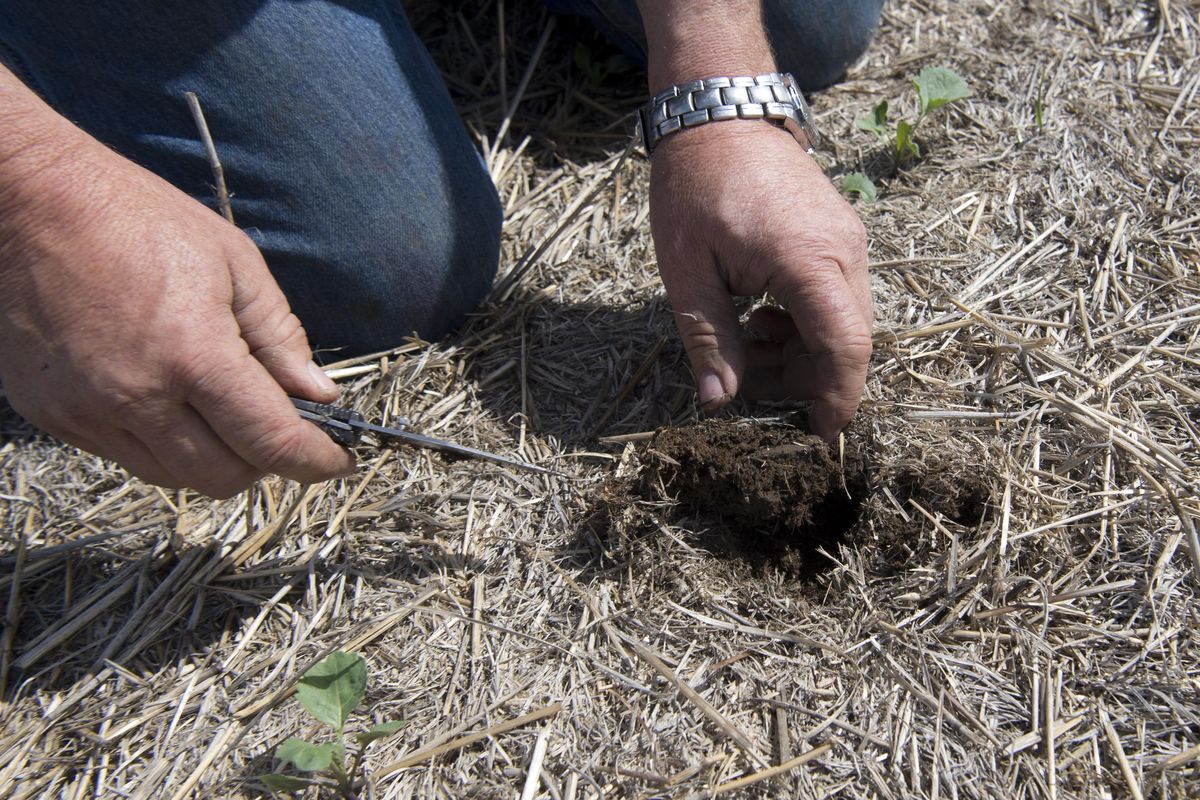‘Direct seeding,’ or no-till farming, one way to cut down on erosion

SPANGLE, Wash. – A dozen years ago, Bob Sievers changed the way he farms 2,700 acres in Washington’s Palouse region.
The third-generation grower used to plow in the fall and rework his fields each spring. By the time the seed went into the ground, Sievers had turned over the dirt six or seven times, burying wheat stubble, breaking up dirt clods and killing weeds.
Now, he makes a single pass over his fields with a drill that inserts seeds and fertilizer, leaving most of the ground undisturbed. The previous year’s stubble stays, giving his fields a shaggy look compared to the highly cultivated black loam in some of his neighbors’ fields.
Sievers is OK with that. Since he switched to direct seeding, his yields for wheat, lentils, canola and other dryland crops have shot up by 10 to 20 percent.
“I farm ugly, and I’m proud of it,” he said. “That black dirt with perfect green rows you’re used to seeing? It’s wrong.”
The Pacific Northwest Direct Seed Association is encouraging more Inland Northwest growers to make the switch to “ugly” farming, touting its environmental and economic benefits.
In places such as the Hangman Creek watershed, direct seeding can make a significant difference in water quality, said Kay Meyer, executive director of the nonprofit association based in Colton, Washington.
“Low-disturbance farming decreases the erosion and chemical runoff from fields,” Meyer said.
Growers save on labor and fuel costs, too, because they make fewer passes over the land.
Direct seeding has had a presence in the Northwest since the late 1970s, but for some farmers it remains a hard sell. More than a century of agricultural tradition dictates turning over soil to prepare a seed bed.
“Now we’re finding after years and years of research that taking out the stubble and old root wads is bad,” Meyer said. “You want the little seeds to grow through all that.”
The stubble acts like a mulch, shading the plant and keeping the soil cool and moist. Decaying root wads contribute to beneficial microbial activity in the soil, she said.
The Pacific Northwest Direct Seed Association represents growers in Washington, Idaho and Oregon, where Meyer estimates that about 50 percent of non-irrigated crops are direct seeded. In the Hangman Creek watershed, government officials hope to increase the number of acres that are direct seeded to improve water quality in the Spokane River tributary. Sign-ups for federal cost-share programs for direct seeding and other erosion-control agricultural practices will start this fall.
“We’re seeing more direct seeding and we’re also seeing people master it,” said Walt Edelen, water resources program manager for the Spokane County Conservation District, which helped secure the $7.7 million in federal cost-share funding. “If you understand how farmers work, people like to watch their neighbor – maybe for 10 years – before they decide whether they think that worked or didn’t. And then they might try it themselves.”
The Pacific Northwest Direct Seed Association is working to increase benefits to growers who adopt the practice.
In Washington, the association has partnered with the state Department of Ecology on a “Farmed Smart” certification for growers using direct seeding. Through the certification, farmers can show state regulators they use proven methods to reduce soil erosion and agricultural runoff.
Seven Washington growers have received the “Farmed Smart” certification, which requires third-party verification of agricultural practices. The association expects to certify another 40 growers before the end of the year.
“Agriculture is being looked at as the next industry that needs to improve so it stops being a contributor to poor water quality,” Meyer said. “This achieves results without a regulatory process.”
Over time, Meyer anticipates that certified farmers could get a premium for commodity crops when they sell to craft breweries and bakeries. Many food manufacturers want to advertise that their ingredients are sustainably grown, she said.
Sievers is among the growers pursuing “Farmed Smart” certification. He farms outside of Spangle in the Hangman Creek and Palouse River watersheds on land that has been in his family since 1940. For him, the switch to direct seeding was a dollars-and-cents decision. The area gets about 18 inches of precipitation annually, which means every bit of moisture counts.
Sievers was looking for ways to improve water retention in his fields and boost crop yields. Testimony from another farmer persuaded him to try direct seeding. A low-interest government loan helped him buy the drill that punches through the stubble and deposits the seed and fertilizer.
Financially, direct seeding had to make sense, Sievers said: “It’s a family farm and a family business. … I’m not doing this for free.”
But the method has proved itself, he said. When thunderstorms dump heavy rain on his fields, Sievers’ ground absorbs the water while conventionally tilled fields send eroded soil into roadside ditches.
“It’s embarrassing to me to be driving to Spokane and to see that muddy water in Hangman Creek,” he said.
Sievers’ late father, Paul, was part of an older generation of farmers who were skeptical about direct seeding. But about three years after Sievers made the switch, his dad – a man of few words – paid his son a glowing compliment.
“He came up to me and put his arm around me,” Sievers said. “Then he said, ‘I think you’re on to something here.’ ”